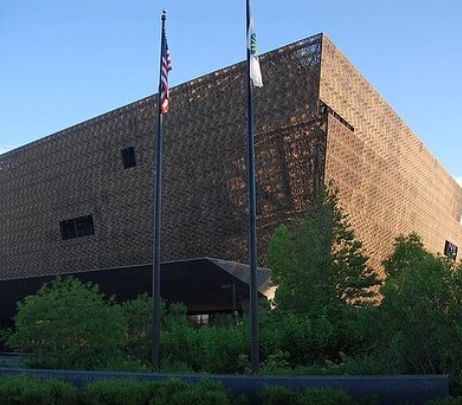Feb 1, 2025

A visit to the African History Museum in Washington DC has been on my bucket list for quite some time. And, this December, my husband and I were fortunate enough to be on a small weekend getaway to the area and thought we would finally sneak in for a “few hours.”
That was the plan. Once we started, however, we quickly realized that a few hours were never going to be enough time and began to cancel other items on our itinerary so that we could spend the better part of a day and a half there instead. I was completely inspired by the displays in DC. Not surprisingly there are not many physical artifacts of the life of the enslaved as they were not permitted the freedom to possess much. But the museum did a splendid job in creating displays that conveyed the depth of their story, nonetheless.
In one display, a stack of bricks towered over a statue of Thomas Jefferson – each inscribed with the name of a person ‘owned’ by him. In another powerful display, a simple shack of a house stood as testament to the living conditions endured by the amazing people that survived and thrived despite that point. One of the stories that struck me the most was the addition of a back door this this humble home – which was not allowed under the rules of slavery and only possible after the family had been freed. Who among us thinks of a back door as freedom?
Thanks to our members and donors, our little town is fortunate to have the space and resources to share the story of Medfield including the hard fact that slaves were very much a part of our history as well. Although we don’t know exactly when the first enslaved person was brought to town, we do know that it was early in our history.
For a little background, 1619 marked the first time a slave ship landed in the colonies at Jamestown Virginia. And, the first enslaved Africans arrived in Boston in 1638 on the ship Desire. Massachusetts became the FIRST English colony in North America to legalize slavery in 1641. Here, closer to home in Medfield, the description of the early meeting house included an upper gallery “occupied by the negro slaves.”
Many visitors to the museum are quite surprised to learn this fact. But it is impossible to refute. To drive the point home, we can share the bill of sale for an enslaved man named Newport Green that we are “fortunate” to have in our collection.
We know that Newport was not the first slave – nor was he the last. There are, in fact, many references to slavery in our town’s history as written by Mr. Tilden.
One such reference was quoted from the will of the second minister of Medfield, Rev. Joseph Baxter, which reads the following: “I devise to my beloved wife, Mercy Baxter, twenty pounds a year in bills of the old tenor, so long as she shall live, besides all the household goods she brought to me, and whatsoever she had by her father, or former husband, or sister; and also my horse and chaise and the tackling belonging to it, and the service of my Negro Slave, Nanny, during my wife’s life; and to my Negro Slave I give her freedom at my wife’s decease.” He afterward adds, “It is my will that upon condition my Negro woman shall not in all things carry and behave herself dutifully and well towards her said mistress, my wife, then she shall not have her freedom; but I give to my wife full power to sell or dispose of her for life at her discretion.”
Reverend Baxter died in 1775. What makes the continued enslavement of Nanny at the time of his death especially interesting is that the town voted in 1773 to ensure that our representative in the legislator to “use his utmost influence to have a final Period put to that most cruel, Inhuman and unchristian practice the Slave Trade.”
We don’t know what happened to Nanny. Slavery would not officially be abolished in Massachusetts until 1784 and it took another 75 years to abolish slavery country wide (1865). Amazingly, it wasn’t until my lifetime that the equal rights amendment was ratified in 1972, almost two hundred years after Reverend Baxter’s death.
Hopefully we will do better during the next 200 years.